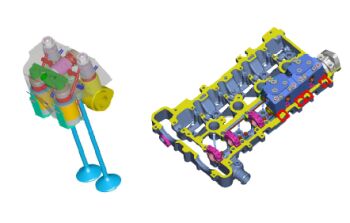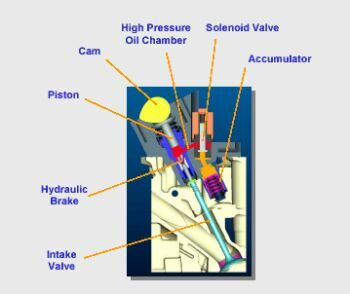![]()
![]()
15.09.2004 Fiat are about to make the next big step in petrol engine technology, a revolutionary new approach to valve actuation, that sweeps away to current established methods
 Fiat
are about to make the next big step in petrol engine technology, a revolutionary
new approach to valve actuation, that sweeps away to current established
methods.
Fiat
are about to make the next big step in petrol engine technology, a revolutionary
new approach to valve actuation, that sweeps away to current established
methods.
The project, known as UNIAIR, has been developed by Centro Ricerche Fiat for almost ten years, and is now production ready.
Ditching the inlet camshaft, UNIAIR sees the tappet piston and the engine intake valve connected through an oil chamber, which is controlled by solenoid valve, itself controlled electronically by commands originating from the driver's throttle pedal actions that have been processed by a control unit.
UNIAIR offers huge range of potential benefits
including distinct advantages in the areas of increased power, improved
low end torque characteristics, minimising engine emissions and wear, and cost saving
through sheer design simplicity.
Fiat's engineers believe that all major
development hurdles have now been successfully overcome and the introduction of
its production application is already in the planning stage. Within the next
couple of years this new technology will be introduced onto cutting-edge Alfa Romeo,
Ferrari and Maserati models.
To appreciate both the relevance and importance of UNIAIR we have to take a quick look first at a wider picture. The European motor industry in general sees the 2008 CAFE target of 140gm/100km CO2 as being a turning point in engine application. It will lead to large displacement engines continuing to be primarily diesels, while smaller engines, under around 1600cc, will be highly efficient petrol units. In the middle, will be the1800-2200cc petrol and diesel engines, fighting against each other to dominate what is the biggest market segment, a battle that will be decided on the efficiency and economy of the engines on offer.
Engine technology will, therefore, focus into addressing the NOx and Particulate Matter emission problems that surround diesel engines while the effort in the petrol field will be concentrated on fuel consumption/CO2 reduction.
The main issue surrounding the petrol engine concerns the elimination, or at least tackling, of the pumping losses at low loads. The technologies under discussion for this aim are: charge dilution by the stoichiometric approach, charge dilution with air, known as the lean stratified approach, physical downsizing or throttleless load control through variable valve actuation.
It is the latter that Fiat's research
staff saw as the optimum
solution, with fringe benefits that can only add ever increasing value to the
process, and this is the route that they have pursued.
Probably the major feature of this new technology, known to Fiat as UNIAIR, is
the independent control of individual intake valves of the engine which allows
modulation of the in-cylinder flow field and turbulence levels. Fiat say, "This
feature enables the enhancement of the combustion rate when necessary, typically
when Early Intake Valve Closing angles are used for load control or in the
presence of heavy EGR, and allows the throttless load control benefits to
prevail upon combustion efficiency deterioration.
"The demonstrated fuel consumption gain is between 8 and 10%, depending on
application; the engine performance is improved in terms of low end torque
and/or maximum power with simultaneous improvement of the vehicle transient
behaviour. Significant cold phase emissions reduction has been shown thanks to
the combustion rate control capability of the system, with possible impact in
terms of exhaust system cost reduction.
The UNIAIR system that CRF has developed was targeted to provide simplicity, low-power requirements, a built-in fail-safe nature and cost-effectiveness. Unlike the other systems mentioned above, flexibility of the UNIAIR concept raises the exciting possibility of also adapting the system for use on diesel applications.
UNIAIR is applied on the intake valves only, mainly due to the
high cost of applying it to the exhaust valves. CRF's engineer's describe the
system, "The tappet piston and the engine intake valve are connected through an
oil chamber, which is controlled by a normally open, on-off solenoid valve. When
the solenoid valve is closed (activated) the intake valve essentially follows
the cam motion (full lift). Early intake valve closing (EIVC) is obtained by
opening (deactivating) the solenoid valve at a certain cam angle. Oil flows out
of the high pressure oil chamber into the low pressure channel.
"The motion of the valve is de-coupled from that of the tappet and, forced by
the valve spring, the valve closes earlier than in the full lift mode. Soft
landing of the intake valve is achieved through a hydraulic dampening unit
(hydraulic brake). During the following re-filling of the high pressure oil
chamber, oil flows back through the open solenoid valve also thanks to the
presence of a spring-loaded accumulator. Similarly, late intake valve opening (LIVO)
can be achieved by retarding the solenoid valve activation.
UNIAIR is hugely flexible, allowing engine patterns to be optimised instantly. It is a very robust application that has also been designed to reduce impact on present cylinder head design as much as possible, work with the current engine oils and have a maintenance free life cycle.
The actuator performance has been improved during the decade of
development in order to achieve a number targets relating to functionality and
durability, mainly
extension of system operating range to very high engine speeds and very low
temperatures, soft engine valve landing in any engine operating condition, low
energy consumption, precise air control at any load/rpm condition, durability of
the actuator/solenoid valves for conventional engine life.
 It has functioned
reliably at engine speeds in excess of 8,000rpm and in temperature ranges from
-30 to 150 degrees.
It has functioned
reliably at engine speeds in excess of 8,000rpm and in temperature ranges from
-30 to 150 degrees.
In a current engine, one which uses conventional throttle body technology, the ECU controls all activities simultaneously through the fuel injection processes, air induction control and ignition spark timing.
For the first production application of the UNIAIR system CRF have seeked to adopt a very flexible approach. According to CRF's engineers, "The UNIAIR Engine Control system consists, for the time being, of two separate units dealing with "Air Control" and "Engine Control". The Air Control unit electronically manages the electro-hydraulic actuation of the engine valves in order to control Air Quantity and Air Quality."
UNIAIR therefore, discards the complicated set-up in use on engines today, features that include the use of throttle cables, inlet valves and switchable tappets, for a much more sophisticated, simpler and cost-effective arrangement.
The ECU still plays its key role, managing all factors relating to engine combustion, while communicating electronically with the UNIAIR's Control Unit. This system has the potential to further integrate, creating an ever more efficient arrangement, that Fiat's engineers call the 'UNIAIR Engine Control System'. This single Control Unit would, it is estimated, bring costs down by 15-20%.
When the accelerator pedal is depressed, the ECU translates this
action into an air mass request which is then sent to the Air Control unit,
which in turn actuates the valves accordingly, after having taken into account
ambient and oil conditions, as well as the engine state and driveability
requests.
Fiat further comment that, "The independent actuation of the two intake valves
opens the way to perform a punctual control of the combustion characteristics by
means of charge motion control. In full load operation and maximum power the
more effective strategy is to operate the valves in "full lift" mode, while
reducing the engine speed the intake valve closure has to be advanced in order
to improve volumetric efficiency. At part load operation various valve
management strategies can be adopted for optimal combustion control and best
overall efficiency."
After demonstrating that they are setting the pace with diesel technology, most recently by the development of the now widely adopted common-rail application, Fiat's engineers have showed themselves to be at the front in petrol field.
Is this the revolutionary step forward that it appears to us? We asked cutting-edge UK-based engineering firm, PNM, who have been developing this electronic valve actuation technology for some time.
"The breakthrough that this new form of valve control represents cannot be underestimated," comments PNM's Managing-Director, Pete Musgrove. "The electronic method of delivery allows the engineer search for complete intake optimisation, and take huge strides towards implementing efficiently impending EU regulation."
"It will change the whole way induction is regarded, and once
high-volume production is factored in, cost savings, not least through the
arrangement's simplicity, will be major, with further future system integration
still wide open."
by Edd Ellison & Stefano Maiano